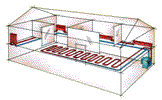 |

 What is Radiant Heat? What is Radiant Heat?
The comfort of radiant heat dates back to the Romans who used this 'luxurious' form of heating to warm their stone and marble tile floors. Today, radiant heat systems are installed in applications ranging from small, single-family homes to 150,000 square foot warehouses.
Radiant heat systems heat objects throughout the room, so you can feel the difference. It simply eliminates cold drafts and keeps the heat at the floor, warming you and the furniture, not the air.
To understand the feeling of radiant heat, imagine a cool day with bright sunshine. If you walk from the shade into the sunlight, you'll instantly feel the warm rays of the sun - that's radiant heat at work!
Hydronic InFloor Heating
"Hydronic" systems use a boiler to heat up hot water and a pump to circulate the hot water in plastic pipes installed in a concrete slab. It is a method of heating that uses hot water or steam instead of air. Hydronic heat lets you choose from several different devices that use these two heating processes. Hot water from a Burnham boiler can be piped to radiant tubing hidden in the floor, to slim baseboard radiators, or to stand-alone radiators. Hot water can also be circulated through a coil in your central air-conditioning unit to heat other living spaces with warm air. Plus, hydronic heating produces more hot water for cooking, washing, hot tubs, swimming pools, and even radiant sidewalks and driveways to melt ice and snow.
Electric Infloor Heating
"Electric" systems use an electric resistance cable, sometimes assembled into a mat or a roll (conceptually similar to an electric blanket) to heat up a thin layer of concrete in the floor structure. The thin electric mats are placed above the sub-floor, just under the flooring material. They will heat the floor in 30 to 60 minutes under tile. They are controlled by a timer and a thermostat and in most cases, the homeowners will preset ON-OFF cycles to provide heat only WHEN he/she needs it and WHERE he/she needs it (selecting rooms and heating from your feet up).
Infrared Heating
A gas fired infra-red heating system emulates the efficiency of the sun by generating radiant energy that is converted into heat when absorbed by objects in its path. Once the infra-red energy is absorbed by the floors, machinery, stock and people, it is then re-radiated to warm the surrounding
air.
This method of heating, as opposed to filling a room with warm air (such as a forced air unit) allows the source of heat to begin at the floor level and not the ceiling. This makes it the most efficient and effective method in which to heat under the diverse conditions present in warehouses, storerooms and even the most immense structures imaginable.

|
|



